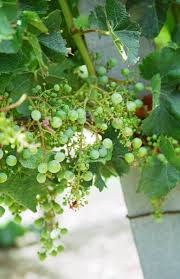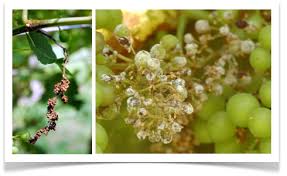The 2012 vintage is coming to a close in the EU. Weather
conditions have been less than ideal in some areas, and others have been lucky
enough to experience bountiful harvests. So which 2012 wines should we be
watching? Below is a region-by-region Western Europe vintage summary which
should prove helpful.
 |
| uneven flowering - the main issue of the 2012 EU vintage |
Portugal:
 2012 followed on the heels of the miserable 2011 vintage,
which saw a large decrease in yield due to root rot. Though the 2012 vintage
wasn’t great, in comparison yields were actually up about 20%. Dry winter
months were followed by a very rainy April, leading to relatively late budding
and flowering. Subsequent hot, dry summer months were capped off by a cooler
August with little rain in the Douro region. The Alentejo, on the contrary, got
a few showers in August.
2012 followed on the heels of the miserable 2011 vintage,
which saw a large decrease in yield due to root rot. Though the 2012 vintage
wasn’t great, in comparison yields were actually up about 20%. Dry winter
months were followed by a very rainy April, leading to relatively late budding
and flowering. Subsequent hot, dry summer months were capped off by a cooler
August with little rain in the Douro region. The Alentejo, on the contrary, got
a few showers in August.
In general, the grapes were small with good color, high
phenolic levels, good ripeness, good acidity, and high potential alcohol. The Alentejo
began its harvest August 21 followed by the Dão, the Douro, and Vinho Verde.
Overall 2012 seems to be a good vintage quality-wise throughout Portugal, and
good quantity-wise as well when compared to 2011. All regions should make some
very good wine this year.
Spain:
 Spain experienced an unusually cool spring followed by a
very hot, dry summer. In the south Cabernet Sauvignon fared horribly, with
yields down 70% in some areas of Andalucía. Cabernet Franc, Merlot, and
Tempranillo did much better. Rioja had a double onslaught of drought and red
spider; allowing selective irrigation salvaged some of the worst-hit vines.
Ribera del Duero saw a decrease in yield of around 15% due to heat shock and
drought. Navarra and the Valencia region, on the contrary, enjoyed good
production levels, with Alicante actually showing an increase in yield for its
sweet wines.
Spain experienced an unusually cool spring followed by a
very hot, dry summer. In the south Cabernet Sauvignon fared horribly, with
yields down 70% in some areas of Andalucía. Cabernet Franc, Merlot, and
Tempranillo did much better. Rioja had a double onslaught of drought and red
spider; allowing selective irrigation salvaged some of the worst-hit vines.
Ribera del Duero saw a decrease in yield of around 15% due to heat shock and
drought. Navarra and the Valencia region, on the contrary, enjoyed good
production levels, with Alicante actually showing an increase in yield for its
sweet wines.
 |
| red spider mite effect |
Quality of Spanish wines is expected to be very good. Though
yields dropped, the remaining berries were of excellent quality and
concentration. Bulk white wine prices have nearly doubled compared to 2011 in
Castilla-La Mancha. Bulk red prices have yet to be determined, but are expected
to exhibit the same trend. Navarra, Ribera del Duero, and Alicante are probably
the regions to watch.
France:
 The 2012 vintage in France will be a very complex subject
with extremely mixed results depending on the region. In general, a cold rainy
spring was followed by an intense heat wave in the summer. These conditions led
to problems during flowering, with varying outcomes.
The 2012 vintage in France will be a very complex subject
with extremely mixed results depending on the region. In general, a cold rainy
spring was followed by an intense heat wave in the summer. These conditions led
to problems during flowering, with varying outcomes.
Bordeaux - Spring rains led to inconsistent flowering and uneven ripening. Extraordinarily
hot days in August (some reaching 104 Fahrenheit) caused some grapes to shut
down, and others to get severe sunburn. The wet spring and hot summer also
resulted in widespread mildew. Late-ripening Cabernet had to be picked in many
cases before ripening was complete in order to avoid botrytis. A few good weeks
just before harvest had some optimistic, but Cabernet-based wines will have a
struggle ahead due to unripe tannins in the pips and skins. Merlot and Cabernet
Franc showed good ripeness and concentration.
 |
| uneven ripening on a Cabernet Sauvignon bunch in Bordeaux |
The right bank will likely fare better than the left bank in
2012. Sauternes will not have a good vintage this year, as the desired botrytis
cinerea did not show up at the critical time.
Burgundy – The weather had a similar effect on the yield in
Burgundy as it did in Bordeaux. However, the Pinot Noir was able to reach full
maturity before any mildew problems occurred. Burgundy producers are comparing
the fruit quality to the 2010 vintage, claiming that the wines will be fewer
but of excellent quality. This is a vintage for aging… but both whites and reds
will be delicious!
The Rhône – Small berries were the result of the weather
conditions in the Rhône this year. Lots of berries, little juice. Yields are
down 20-25% in key regions such as Châteauneuf-du-Pape, Hermitage, Condrieu,
and Cornas. But producers are very optimistic about the quality of the wines. They
much prefer 2012 to 2011, and compare it to 2007 (which they quite liked). Good
acidity and very, very ripe grapes are raising expectations about 2012 Rhône
wines… keep your eye on these.
Champagne – Not much to say here. Champagne suffered some of
the worst losses of all of the EU. Estimates state that 2,600 hectares were
lost to frost. Chardonnay fared the worst. Vintage Champagne won’t be common
from 2012…
The Loire and the South – Similar effects were seen in the
Loire and the south of France as in Burgundy: decreased yield (down 50% in
Muscadet!) but fantastic quality. No rot was seen. This will be a small but
great vintage in the Loire, and a medium-yield, good vintage in the south.
Italy:
 Italy witnessed an early harvest in all regions. Heat and
drought were suffered here along with the rest of the EU, but yields in general
only dropped about 10%. This is, of course, compared to the already low yields
of 2011. In fact the last 5 years have been very low-yielding, leading to a
shortage rather than the usual surplus of wines in Italian cellars. Luckily
this mainly affects the bulk wine market and not the craft wines of Barolo, Barbaresco,
Tuscany, etc.
Italy witnessed an early harvest in all regions. Heat and
drought were suffered here along with the rest of the EU, but yields in general
only dropped about 10%. This is, of course, compared to the already low yields
of 2011. In fact the last 5 years have been very low-yielding, leading to a
shortage rather than the usual surplus of wines in Italian cellars. Luckily
this mainly affects the bulk wine market and not the craft wines of Barolo, Barbaresco,
Tuscany, etc.
Early varietals were penalized most (in general) in 2012 due to the
unfavorable weather conditions. Merlot was decimated, along with early ripening
whites throughout the country. Italian varietals were definitely favored.
Alto Adige – Heat and peronospora proved challenging for producers
in Alto Adige. A hot and humid July and August forced some to pick as early as
August 30. Later ripeners like Merlot and Cabernet suffered due to a cold front
with lots of rain beginning September 15. Yields were down typically about 20%.
Early ripening grapes, however, managed to produce fresh, elegant wines in
which the producers are taking a lot of pride. Pinot Noirs and whites will be
wonderful.
 |
| peronospora in Alto Adige |
Tuscany – Whites did much better than reds in Tuscany. The
Vermentino in particular will show remarkably well. In Bolgheri and Montalcino,
yields are reported to be down 25-30%. However vineyards with old vines that
withstood the drought conditions more easily (emergency irrigation is forbidden
here) will make excellent, concentrated wines. The Sangiovese that made it to
harvest showed excellent color, very good acidity, and deep, rich flavor. The best
producers in Tuscany with old vineyards will find that the 2012 vintage is
legendary.
Piedmont – A cooler-than-average May and June with loads of
rainfall resulted in the standard 2012 bud loss. June was warm and sunny,
without the excessive heat experienced by many regions perhaps due to the
tempering winds from the Ligurian sea. A slightly early harvest of slightly
less fruit isn’t seeming to worry the Piemonte producers, who have very high
hopes for the 2012 vintage.
Emilia Romagna – Weather conditions here forced emergency
irrigation in an attempt to rescue the overstressed vines. Yields are way down
(30-50%); in fact, 2012 is known as the lowest yielding vintage in the last 50
years. Chardonnay and Pinot Bianco harvest began 10 days to a month early.
Later ripening grapes took advantage of some much-needed rainfall and were
harvested relatively on time. Lambrusco ripened quite well, with good acidity
and perfect concentration. Barbera, Lambrusco, and Bonarda are probably the
wines to look for… Trebbiano, on the other hand, suffered most.
Southern Italy and Sicily – 2012 was HOT in the south. But
the reports coming in state that the grapes were healthy and balanced at the
time of harvest. The ability to irrigate saved many vines and allowed the south
to manage its losses well. This should be an OK vintage.
Germany:
 A disappointing spring and summer was followed by
gloriously sunny and warm conditions as harvest approached. Very little
reduction in yield was reported. Germany did not see the intense heat wave
experienced by the rest of Western Europe, and instead had mellow, warm
conditions that encouraged even and healthy ripening. Pinot Noirs look
especially good, and though there is a slight drop in acidity in the Rieslings,
they look very good as well.
A disappointing spring and summer was followed by
gloriously sunny and warm conditions as harvest approached. Very little
reduction in yield was reported. Germany did not see the intense heat wave
experienced by the rest of Western Europe, and instead had mellow, warm
conditions that encouraged even and healthy ripening. Pinot Noirs look
especially good, and though there is a slight drop in acidity in the Rieslings,
they look very good as well.
This brief 2012 EU vintage report should give a general
idea of conditions throughout Western Europe. In summary, look out for the Douros,
the Burgundies, the Northern Rhônes, the old-vine Sangioveses and Vermentinos
from Tuscany and Sardegna, the Pinots from Alto Adige and Germany, and the Ribera
del Dueros and Alicante wines from Spain. The Barolos and Barbarescos, German Rieslings, and Loire wines should be pretty good. I would be particularly wary of the
Bordeaux, the Cabernets and Merlots from Italy, the wines from Emilia Romagna (except the Lambruscos), the Riojas, and the Bordeaux
varietals from the south of Spain. We’ll have to see how these turn out…
- Sarah
 7. Strike! Hit the blunt edge of the knife against the rim
of the bottleneck firmly in one swift, straight movement… but a knock more than
a full-force blow. You may need to do this a few times, depending on the bottle.
Scrape the knife along the seam before each swing.
7. Strike! Hit the blunt edge of the knife against the rim
of the bottleneck firmly in one swift, straight movement… but a knock more than
a full-force blow. You may need to do this a few times, depending on the bottle.
Scrape the knife along the seam before each swing.




